Venetian Art Was Strongly Influenced by color and innovations

Saint Mark's Square and the Doge's Palace seen from the h2o, Venice (Italia) (photo: Steven Zucker, CC By-NC-SA ii.0)
Venice – some other globe
Petrarch, the fourteenth-century Tuscan poet, called Venice a "mundus alter" or "another world," and the urban center of canals really is unlike from other Renaissance centers similar Florence or Rome.
Venice is a cluster of islands, connected by bridges and canals, and until the mid ninteenth century the only fashion to reach the city was by boat. In the fifteenth and sixteenth centuries Venice suffered numerous outbreaks of the plague and engaged in major wars, such as the War of the League of Cambrai. Just it too boasted a stable republican government led by a Doge (meaning "Duke" in the local dialect), wealth from trade, and a unique location as a gateway between Europe and Byzantium.
The Venetian Mode

Giovanni Bellini, San Zaccaria Altarpiece, 1505, oil on wood transferred to canvass, xvi′ v-1/2″ ten vii′ ix″ (San Zaccaria, Venice) (photo: Steven Zucker, CC By-NC-SA 2.0)
Painting in Early and High Renaissance Venice is largely grouped effectually the Bellini family: Jacopo, the male parent, Giovanni and Gentile, his sons, and Andrea Mantegna, a brother-in-law. Giorgione may have trained in the Bellini workshop and Titian was apprenticed in that location as a boy.
The Bellinis and their peers developed a specially Venetian style of painting characterized by deep, rich colors, an emphasis on patterns and surfaces, and a potent interest in the effects of low-cal.

Saint Marker's Basilica, Venice, begun 1063, Middle Byzantine
While Venetian painters knew almost linear perspective and used the technique in their paintings, depth is simply equally frequently suggested by gradually shifting colors and the play of light and shadow. Maybe Venetian painters were inspired by the glittering aureate mosaics and atmospheric lite in the chiliad Cathedral of San Marco, founded in the 11th century? Or maybe they looked to the watery cityscape and the shifting reflections on the surfaces of the canals?
Oil pigment
The Venetian merchandise networks helped to shape local painting practices. Ships from the East brought luxurious, exotic pigments, while traders from Northern Europe imported the new technique of oil painting. Giovanni Bellini combined the two by the 1460'southward-70's. In the next few decades, oil paint largely supplanted tempera, a quick-drying paint leap by egg yolk that produced a flat, opaque surface. (Botticelli's Birth of Venus is ane example of tempera pigment, which y'all tin can learn more about hither).

Giorgione, The Admiration of the Shepherds, 1505/1510, oil on panel, 35 3/four x 43 1/two″ / 90.8 x 110.5 cm (National Gallery of Fine art)
To achieve deep tones, Venetian painters would prepare a panel with a polish white ground and so slowly build upwardly layer-upon-layer of oil pigment. Since oil dries slowly, the colors could be blended together to reach subtle gradations. (See this effect in the rosy flush of the Venus of Urbino's cheeks past Titian or in the blue-orange clouds in Giorgione'south Adoration of the Shepherds—above). Plus, when oil paint dries it stays somewhat translucent. Every bit a result, all of those thin layers reflect light and the surface shines. Painting conservators have fifty-fifty found that Bellini, Giorgione, and Titian added footing-upwardly drinking glass to their pigments to meliorate reflect light.
Venetian painting in the 16th century

Paolo Veronese, The Dream of Saint Helena, c. 1570, oil on sheet, 197.5 x 115.six cm (The National Gallery, London)
Over the next century Venetian painters pursued innovative compositional approaches, like asymmetry, and they introduced new subjects, such as landscapes and female person nudes. The increasing use of pliable canvas over solid woods panels encouraged looser brushstrokes. Painters besides experimented more with the textural differences produced past thick versus thin awarding of paint.
In the Late Renaissance Titian'due south mastery was rivaled by Tintoretto and Veronese. Each attempted to out-pigment the other with increasingly dynamic and sensual subjects for local churches and international patrons. (Phillip II of Spain was particularly enamored with Titian's mythological nudes.) The trio transformed saintly stories into relatable man drama (Veronese's The Dream of St. Helena), captured the wit and wealth of portrait subjects (Titian's Portrait of a Man), and interpreted nature through mythological tales (Tintoretto'south The Origin of the Galaxy).
Boosted resource:
Sacra Conversatione from The National Gallery
Titian on The Metropolitan Museum of Art's Timeline of Art History
Madonna of the Pesaro Family from the University of Mary Washington
Bellini, Giorgione, Titian, and the Renaissance of Venetian Painting
Smarthistory images for teaching and learning:


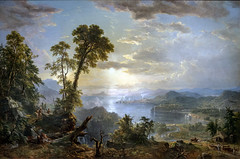
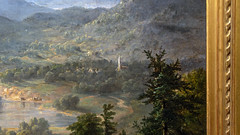
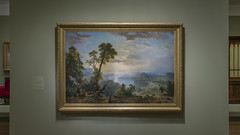


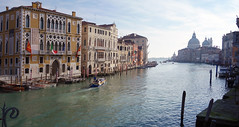
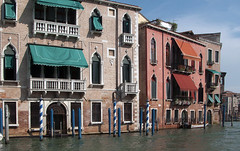
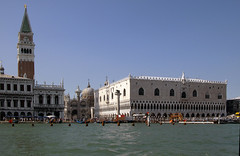
More Smarthistory images…
Source: https://smarthistory.org/venetian-art-an-introduction/
0 Response to "Venetian Art Was Strongly Influenced by color and innovations"
Publicar un comentario